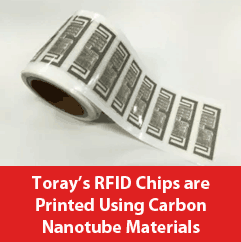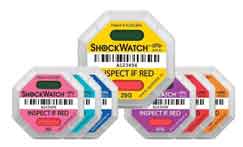For many years, business users have awaited development of so-called printable RFID circuits, as a means of significantly reducing costs – maybe getting to a one-cent tag that would dramatically open up applications by changing the ROI dynamics.
Supply Chain Digest Says... |
 |
| The technology is not yet ready for commercialization, with Toray saying it will enter the smart tag business as early as 2022. |
 |
What do you say? |
| Click here to send us your comments |
 |
| Click here to see reader feedback |
|
|
All the way back in 2007, an SCDigest news story noted that "A start-up company called Kovio (Sunnyvale, CA) made public technology it has been quietly developing for several years, based on research work originally performed at MIT University. The company's technology makes it possible to actually print transistors using commercially available technologies such as high-end commercial ink jet printers. RFID tags are just one of many target applications."
As far as SCDigest can tell, news about the supposed printable RFID breakthrough stopped by 2008.
A Google search finds little recent news about printable RFID circuits.
However, last week there was news that a Japanese chemistry company called Toray Industries has claimed it has developed the world‘s first ultrahigh frequency (UHF) radio-frequency tag with a printed semiconductor.
The company says its flexible RFID tag can be made used a semi-conductive carbon nanotube composite material that can allow the manufacture of UHF RFID chips using low-cost printing processes.
That, Toray says, could dramatically reduce the cost per tag, as the traditional silicon-based RFID tags are comparatively expensive to produce due to the complex manufacturing processes employing high temperatures and vacuum environment. Such tags also require the IC chip to be mounted onto a label material.
(See More Below)
|
CATEGORY SPONSOR: SOFTEON |
|
|
| |
|
|
Toray's approach, by contrast, uses technology that involves printable circuits, focusing on high-performance carbon nanotube composite materials that are printed on to a film substrate.
 The company says its new technology may reduce the cost of RFID tags by 80% to less than 2 cents each, specifically targeting a price point of 1.8 cents. The company says its new technology may reduce the cost of RFID tags by 80% to less than 2 cents each, specifically targeting a price point of 1.8 cents.
Toray says its RFID prototype incorporates a 24-bit memory that is entirely printed using the new proprietary material and process technologies. It says the chip is able to communicate wirelessly on the UHF spectrum (860–960 MHz) at distance of 20 centimeters.
Toray says its next goal is to design a 60-bit memory and improve communication performance, including communication distance, while developing on-film manufacturing technologies to commercialize the printed RFIDs.
The technology is not yet ready for commercialization, with Toray saying it will enter the smart tag business as early as 2022.
Toray's research was supported in part by the 'Low Carbon Technology Research and Development Program"
of Japan's Ministry of the Environment.
Will this apparent breakthrough make it to the other side and deliver on its claims? We should know in a couple of years, but if yes it will be a game changer.
Any thoughts on this new technology? Let us know your thoughts at the Feedback section below.
Your Comments/Feedback
|

